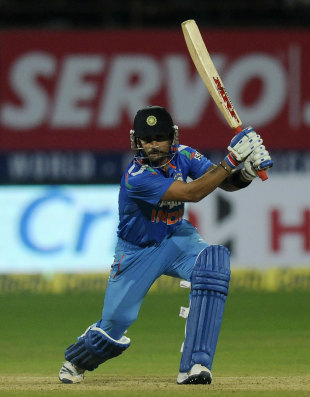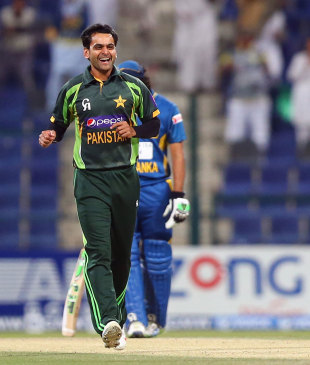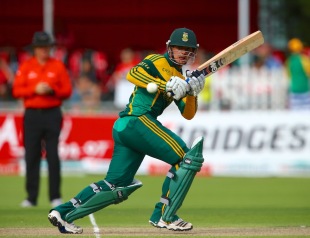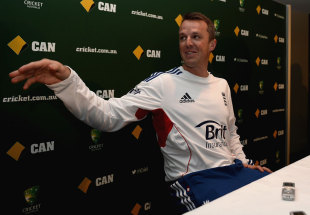The Test, ODI and T20I XIs of 2013, as picked by ESPNcricinfo's staff

AB de Villiers shone bright in both Tests and ODIs in 2013 © Getty Images
TEST
David Warner
909 runs at 39.52
It was a year of two halves for Warner, either side of a cantankerous phase in May-June when he vented against a couple of journalists on Twitter and punched Joe Root at a Birmingham bar. He had a forgettable tour to India - despite two fifties - but he finished 2013 in style with 124, 83 not out, 60 and 112, which helped Australia regain the Ashes in 14 days.
Hashim Amla
633 runs at 57.54
He's not a traditional opener but Amla walked in inside the first ten overs in five innings this year. And with two hundreds and four fifties in eight matches in 2013, he continued to power South Africa's quest to remain the No. 1 Test side. He began with 66 and 110 in the 2-0 whipping of New Zealand and notched up three half-centuries against Pakistan at home. His most memorable knock was a century on the first day of the series in Abu Dhabi, where he showed immense patience and technique to help his side stay afloat.
Cheteshwar Pujara
829 runs at 75.36
With a double-hundred, two hundreds and three fifties, Pujara was undoubtedly India's star batsman through the year. His 204 in Hyderabad set up a massive win against Australia and he continued to torture them with twin fifties in the final Test in Delhi. An innings of 113 against West Indies in Mumbai followed, but he saved the best for last: a masterful second-innings 153 in Johannesburg, on a tricky pitch, against the world's best side.
Michael Clarke
1093 runs at 47.52
The leading run scorer in 2012 also led the charts in 2013. Unlike in 2012, though, Clarke didn't post monster scores but his four hundreds and three fifties were instrumental in reviving Australia. He was one of the few notable performers on their horrid tour to India, and he came away from the Ashes in England with a century and a fifty. However, his most inspired efforts were hundreds in Brisbane and Adelaide, innings that helped take Australia to Ashes glory after a four-year gap.
Ian Bell
1005 runs at 41.87
Bell had a relatively quiet start to the year, with just one half-century in the first half, but he exploded during the home Ashes with three hundreds and two fifties. On three occasions, with England in trouble, he pulled off match-defining hundreds that stood out for their strokeplay and assured defence. Through the year he also showed that he was one of the best short-leg fielders in the world.
AB de Villiers
933 runs at 77.75; 45 catches, one stumping
Since Adam Gilchrist retired in 2008 few wicketkeeper-batsmen have made the kind of impact that de Villiers did in 2013, when he finished as the top-ranked Test batsman. His four hundreds and five fifties showcased his versatility - he could snatch the advantage, consolidate a solid foundation, and also knuckle down and play out time. His 46 dismissals behind the stumps made him the most valuable Test cricketer of the year.
Stuart Broad
62 wickets at 25.80, 326 runs at 16.30
If we look beyond Broad's decision on July 12 - to not walk when he edged a delivery from Ashton Agar to first slip (via the wicketkeeper's gloves) - we will find a set of stellar performances in varying conditions: 6 for 51 in a draw in Wellington, a lethal 7 for 44 against New Zealand at Lord's, an Ashes-winning 11-wicket haul in Chester-le-Street, and a hard-working 6 for 81 in a loss in Brisbane. We will also see a lower-order batsman offering gritty resistance at important times through the year.
Mitchell Johnson
34 wickets at 17.52
He played only six Tests in the year but turned in spells so blistering that he drew comparisons with past masters like Jeff Thomson, Malcolm Marshall and Waqar Younis. With nine wickets in Brisbane, eight in Adelaide (including a scorching 7 for 40 that demolished England), six in Perth, and eight in Melbourne, he stamped his will on the Ashes, and, six years since his Test debut, showed us why Dennis Lillee called him a "once-in-a-generation bowler".
Dale Steyn
51 wickets at 17.66
Not many Pakistan batsmen will forget the devastating 8.1-6-8-6 that Steyn served up in Johannesburg, bowling them out for 49. He added five wickets in the second and picked up his second successive Man-of-the-Match award (after he had blown away New Zealand a few weeks earlier). He was hostile in unhelpful conditions too, taking eight wickets in two Tests in the UAE, and ended the year with a series-winning nine-wicket haul against India in Durban.
Saeed Ajmal
37 wickets at 24.72
He made his Test debut in 2009 but Ajmal had played only eight Tests outside Asia before 2013. In five Tests in southern Africa, he mesmerised batsmen across different conditions: his masterclass in Cape Town fetched him ten wickets in the match (in which Pakistan nearly pulled off a win) and his 11 wickets in Harare led them to a big win. As always he was a terror in the UAE and nabbed 12 wickets in the drawn two-match series against South Africa.
Ryan Harris
38 wickets at 21.94
A terrific bowler when fit, Harris shouldered a large part of the burden on Australia's tough trip to England. He often bowled more than 20 overs per innings and provided breakthroughs when games appeared to be slipping away. In the return series, he was a vital foil for Johnson and turned in some memorable spells in Adelaide and Perth.

Virat Kohli got to 5000 ODI runs in his 114th innings, the same as Viv Richards © BCCI
ODI
Shikhar Dhawan
1162 runs at 50.52
India's success in the one-day format was largely because of the solidity at the top of the order and Dhawan, with a strike rate of 97.89, often played the lead role. His 363 runs in the Champions Trophy - including two hundreds - won him the Player-of-the-Series award, and he ransacked 95, 100 and 60 in the home series against Australia.
Rohit Sharma
1196 runs at 52.00
Another fire starter at the top of the order, Rohit blossomed into one of the mainstays in India's line-up. His eight fifties set up many a tall score but he will always remember 2013 as the year he cracked 16 sixes - the most in an ODI innings - in his stupendous series-winning 209 against Australia in Bangalore.
Kumar Sangakkara
1201 runs at 63.21; 26 catches, six stumpings
He was the highest run scorer in 2012 and came close again with a string of influential performances. His 372 runs in the series against South Africa at home - including a monster 169 - led Sri Lanka to a 4-1 win. The other high point was his dazzling 134 at The Oval against England in the Champions Trophy.
Virat Kohli
1268 runs at 52.83
Melding Tendulkar's composure and Sehwag's derring-do, Kohli reinvented the art of batting in the middle overs of ODIs. His four hundreds and seven fifties showcase his consistency, but stats can't reveal the ruthlessness with which he chased down massive targets, or the control he showed while pacing an innings. The piece de resistance was the 52-ball hundred - the fastest by an Indian - against Australia in Jaipur when they hunted down 359 in a mind-blowing 43.3 overs.
George Bailey
1098 runs at 64.58
Few Australian batsmen have had as meteoric a rise in ODIs as Bailey - who has racked up more than 1500 runs in his first 35 games. His 1098 runs in 2013 came at a eye-popping average and he has been head and shoulders ahead of the rest of the batting line-up over the last couple of years. The ODI series in India was the watershed: he amassed 478 runs at 95.60.
AB de Villiers
1163 at 50.56, 25 catches
De Villiers finished the year in style, topping the ICC's Test and ODI rankings after the home series against India, where he tallied 189 ODI runs from three innings. For much of the year he feasted on the Pakistan attack - both home and away - carting them for two hundreds and four fifties over 14 matches. He also kept wicket for half of South Africa's ODIs in the year and took 17 catches behind the stumps.
MS Dhoni
753 runs at 62.75; 21 catches, 13 stumpings
Arguably the most valuable one-day player in the world, Dhoni repeatedly hoodwinked opponents with his skilful batting and wily captaincy. There were plenty of memorable wins through the year - a Champions Trophy triumph that made him the first captain to win all ICC trophies; a tri-nation series victory in the West Indies, where he smacked 16 off the last three balls with No. 11 for company; and a series win against Australia at home that included a scintillating 139 in a losing cause. He also had 34 dismissals behind the stumps.
Ravindra Jadeja
462 runs at 35.53, 52 wickets at 25.40
The man they call Sir came of age as a left-arm spinner in 2013, and his 52 ODI wickets played a big part in India's rise to the top. Two performances stood out: his 5 for 36 against West Indies in the Champions Trophy and his 4 for 23 against Sri Lanka in the tri-series final in Port-of-Spain. He also had the small matter of 462 runs at 35.53, which made him one of the leading allrounders in the format.
Saeed Ajmal
62 wickets at 20.45
The leading wicket-taker in 2013, Ajmal began the year with 3 for 20 against India in Kolkata, a match where Pakistan wrapped up the three-match series. He finished with starring roles in two more series wins - a historic triumph in South Africa and a victory against Sri Lanka in UAE. In between he put together controlled performances against West Indies and Zimbabwe, and it came as no surprise that he finished the year atop the ICC ODI bowlers' rankings.
Mitchell McClenaghan
40 wickets at 19.02
McClenaghan's 4 for 20 on debut, the best by a New Zealander in his first match, kickstarted his side's revival during their fairytale series win in South Africa. He continued his good form through the England series at home, and in the Champions Trophy, where he troubled batsmen with sudden bursts of pace and sharp bounce. He picked up four or more wickets five times during the year - the best by ODI bowlers in 2013.
Junaid Khan
52 wickets at 21.46
Entrusted with the final over against South Africa in Port Elizabeth, Junaid fired in yorker after yorker to defend nine runs and hand Pakistan their first-ever ODI series win over South Africa. He also had an impressive time in the West Indies, and gave Sri Lanka a hard time during their five-match series in UAE with the most wickets (13) at 16.07.

Mohammad Hafeez lost his spot in the Test side but continued to be stellar in the shorter formats © AFP
T20
Aaron Finch
262 runs at 43.66, SR 194.07
Finch's world-record 156 stunned England at the Ageas Bowl as he led Australia to their first victory in any format over a dismal Ashes tour. A month and a half later he exploded again, this time against India in Rajkot, but his 52-ball 89 was in vain, as Australia lost by six wickets.
Alex Hales
247 runs at 49.40, SR 153.41
Two big innings for Hales this year: a series-winning 80 not out against New Zealand in Wellington and a series-levelling 94 against Australia in Chester-le-Street - a knock that took him to the top of the T20 rankings in September.
Mohammad Hafeez
323 runs at 35.88, SR 132.92; 12 wickets at 21.50
He may have had a horrid year in Test cricket - where he lost his spot in the side - but Hafeez has been stellar in T20s. In March, during the series-winning match in Centurion, he became the first Pakistan batsman to 1000 T20 runs and flattened South Africa with his quickfire 86. He slammed two more fifties in the year and chipped in with wickets at crucial stages of games.
Faf du Plessis
234 runs at 39.00, SR 108.83
A 65-ball 85 in Hambantota was in vain, as Sri Lanka posted a consolation win, but du Plessis played a vital role in South Africa's 2-0 series win against Pakistan in Dubai. An unbeaten 37 in the first match was followed by a controlled (and again unbeaten) 58 in the second, his fourth half-century in the format.
JP Duminy
190 runs at 63.33, SR 125.82; 4 wickets at 8.75
Duminy's 51 and three wickets in Colombo enabled South Africa to recover from a perilous 21 for 3. He struck a controlled 30 in the second game, which played a big part in South Africa winning the series. An unbeaten 47 against Pakistan in Cape Town rounded off a consistent year.
Jos Buttler
130 runs at 32.50, SR 175.67; 6 catches
Providing valuable lower-order firepower, Buttler turned into a vital cog in England's T20 wheel. His innovate, often electric, strokeplay has propped up the lower order and England's think tank seem to believe Buttler can eventually don the gloves in all three formats.
Thisara Perera
125 runs at 125.00, SR 178.57; 8 wickets at 22.00
A handy batsman, cunning bowler and electric fielder, Perera was switched on through the year. He starred in the two matches in Australia - his 15-ball 35 helped wrap up the series 2-0 in Melbourne - and contributed with wickets at critical stages during the series against South Africa (at home) and Pakistan (in Dubai).
Shahid Afridi
199 runs at 39.80, SR 143.16; 10 wickets at 27.20
A key component of Pakistan's T20 side, Afridi chipped in with bat and ball through the year. Two performances stood out: a 20-ball 39 in the first T20 against Sri Lanka in Dubai and three wickets in the win over South Africa in Cape Town.
Sachithra Senanayake
10 wickets at 12.20
A tall offspinner who played a handful of limited-overs matches in 2012, Senanayake's career took off in 2013. First came the $625,000 offer from Kokata Knight Riders, then a comeback into the national side. Fruitful spells followed. He grabbed six wickets in the three-match series against South Africa, going at a shade over five an over, and played a big part in Sri Lanka drawing the series against Pakistan in Dubai.
Jade Dernbach
13 wickets at 15.00
He lost his place in England's ODI side but Dernbach continued to grow in stature in the shortest format. He had four three-wicket hauls during the year, the most recent being the 3 for 23 against Australia in Chester-le-Street.
Sunil Narine
8 wickets at 13.50
He played only five T20 internationals in 2013 but Narine was always a threat, nabbing wickets and restricting batsmen with his unconventional deliveries. He finished with an economy rate of 5.40 - the third-best among bowlers with at least 20 overs in the year. His 2 for 19 played a crucial role in West Indies' win over Australia in Brisbane, their first in any format for 16 years.


















